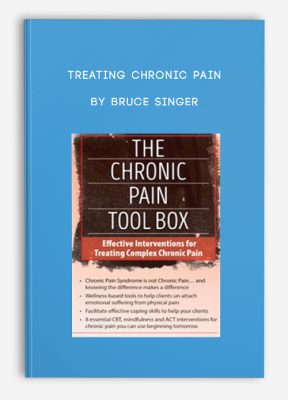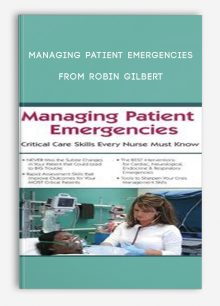Treating Chronic Pain: Effective interventions you can use tomorrow by Bruce Singer
$199.99 $59.00

Treating Chronic Pain: Effective interventions you can use tomorrow by Bruce Singer
**More information:
Get Treating Chronic Pain: Effective interventions you can use tomorrow at Salaedu.com
Description
Do you have clients who describe their chronic pain like, “my back is KILLING me” or “I just want my life back“? They want a life that isn’t controlled by pain… before it limited their activity, interfered with their sleep, and prompted the affair with their beloved opiate. They want a life that isn’t based on fear of even greater pain and suffering…
For clients with chronic pain, even after the physical injury has healed, when the pain persists, the spiritual and emotional effects can be devastating — depression, addiction, anger, loss and fear are just a few.
Transfuse hope into your clients’ lives with evidence–based behavioral interventions that work!
Join nationally recognized expert Bruce Singer, Psy.D., in this intensive online course to get step–by–step instructions for essential CBT, mindfulness and ACT interventions for treating chronic pain and co–occurring disorders that you can use tomorrow to evoke positive change for your clients.
You’ll gain cutting–edge assessment and treatment techniques for complex chronic pain that will help your clients un-attach emotional suffering from their physical pain so they can move toward acceptance and transition from a pain-centered life to a function–centered life.
Plus, when you enroll today you’ll also get TWO FREE BONUSES, including an online video training that digs into the opioid epidemic and offers additional mindfulness and CBT approaches to help your clients, and a free ebook that will teach you how to treat pain without pills and with confidence, Treating Chronic Pain: Pill–Free Approaches to Move People From Hurt To Hope.
- Chronic pain syndrome and why conventional treatments fail
- Societal impacts of chronic pain
- Long-term effects of opiate use
- Biopsychosocial model of pain and how it affects overall quality of life
- APA division 12 treatment recommendations
- Treatment goals and why setting them is so important for your clients’ outcomes
- Self–management strategies & evidence–based skills that don’t involve opioids
- Chronic pain assessment strategies and worksheets
- Diagnosis and treatment recommendations
- Cognitive behavioral therapy (CBT) strategies for chronic pain treatment
- How to harness a client’s self–talk through cognitive restructuring
- Mindfulness-based pain management interventions
- Creative interventions to help clients see “What is NOT wrong with me”
- Wellness skills, active coping skills, gratitude activities, and more
- Cognitive defusion and how to use it with your clients
- The illusion of control and how it affects our lives
- The Values Compass and how to help clients find their True North
- The hidden power of gratitude and its effect on overall happiness
The opioid epidemic is spilling into consulting rooms as more therapists encounter clients overusing these dangerous medicines to treat their chronic pain. Although behavioral interventions are the treatment of choice for pain, prescriptions for opioids — the least effective and riskiest treatment option — continue to rise.
Led by therapist Martha Teater, MA, LMFT, LCAS, LPC, and physician Donald Teater, MD, MPH, this workshop recording digs into the epidemic, and mindfulness and CBT approaches that bring dramatic improvements to people with pain.
- Proven CBT applications to improve quality of life
- Mindfulness tools designed to reduce pain
- Non–opioid medical options and alternative therapies
- Session–by–session treatment plan for individuals and groups
- Unique worksheets, guides, exercises
- Case examples
More information about Medical:
Medicine is the science and practice of establishing the diagnosis, prognosis, treatment, and prevention of disease.
Medicine encompasses a variety of health care practices evolved to maintain and restore health by the prevention and treatment of illness.
Contemporary medicine applies biomedical sciences, biomedical research, genetics, and medical technology to diagnose, treat, and prevent injury and disease,
typically through pharmaceuticals or surgery, but also through therapies as diverse as psychotherapy, external splints and traction, medical devices, biologics, and ionizing radiation, amongst others.
Medicine has been around for thousands of years, during most of which it was an art (an area of skill and knowledge) frequently having connections to the religious and
philosophical beliefs of local culture. For example, a medicine man would apply herbs and say prayers for healing, or an ancient philosopher and physician would apply bloodletting according to the theories of humorism.
In recent centuries, since the advent of modern science, most medicine has become a combination of art and science (both basic and applied, under the umbrella of medical science).
While stitching technique for sutures is an art learned through practice, the knowledge of what happens at the cellular and molecular level in the tissues being stitched arises through science.
1 review for Treating Chronic Pain: Effective interventions you can use tomorrow by Bruce Singer
Add a review Cancel reply
Related products
HEALTH - FITNESS - LIFESTYLE - MEDICAL
HEALTH - FITNESS - LIFESTYLE - MEDICAL
HEALTH - FITNESS - LIFESTYLE - MEDICAL
HEALTH - FITNESS - LIFESTYLE - MEDICAL
HEALTH - FITNESS - LIFESTYLE - MEDICAL
HEALTH - FITNESS - LIFESTYLE - MEDICAL
HEALTH - FITNESS - LIFESTYLE - MEDICAL










Trevis Trevis –
Welcome to Sala Shop, we are here to provide everything to learn and improve this life…encourage you to check clearly the course